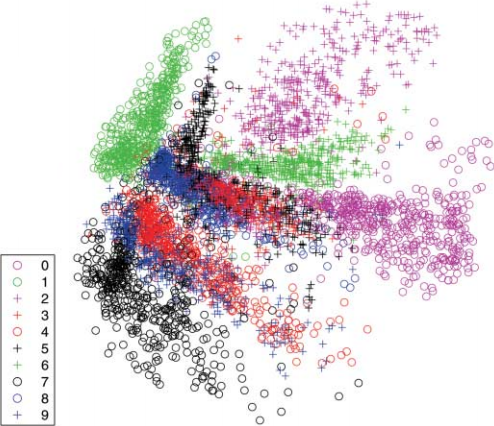Generative Models
- Typical scenario: a model finds a representation $h = f(x)$ of a datapoint (image) $x$
- Generative models can produce an image $x$ from its representation $h$
Autoencoders
- An encoder network followed by a decoder network
- Encoder compresses the data into a lower-dimensional vector
- Given powerful enough decoder, in theory the original datapoint could be perfectly reconstructed even from a one-dimensional latent representation
- A standard autoencoder learns representations with distinct clusters and lack of regularity in the latent space
- In order to generate new content we would need a way to sample meaningful latent representations
Variational Autoencoder (VAE)
- VAE encoder produces two vectors: means and variances for a set of random variables
- The input of the decoder is a sample of these random variables
- The latent space is continuous

Generative Adversarial Nets (GAN)
- Simultaneously train two models, generator $G$ and discriminator $D$
- $G$ learns a mapping from a prior noise distribution to the data space
- $D$ predicts the probability that a sample is from the training data rather than was generated by $G$
- A conditional GAN is obtained by adding an additional input to both $G$ and $D$ (for example, image category or an input image)
pix2pix
- The difficulty with training an image-to-image network is what loss to optimize
- For example, Euclidean distance is minimized by averaging all plausible outputs, producing blurry results
- GAN learns the loss function automatically
- A conditional GAN that is conditioned on the input image is suitable for image-to-image translation
- Generator is based on the U-Net architecture
- PatchGAN discriminator penalizes structure at the scale of local image patches only
- The discriminator is run convolutionally across the image, averaging responses from all patches
- Additional L1 loss encourages the output to be similar to the ground truth
CycleGAN
- Two generators, $G$ and $F$, translate images between two domains
$$
\begin{align}
&G: X \to Y \\
&F: Y \to X
\end{align}
$$
- Generator is a CNN consisting of an encoder, transformer, and a decoder
- Two discriminators, $D_Y$ and $D_X$, try to distinguish real images from generated images
- Discriminator is a CNN that follows the PatchGAN architecture
- Adversarial loss for $G$ makes $D_Y$ distinguish $G(x)$ from $y$:
$$
\begin{align}
&D_Y(y) \to 0 \\
&D_Y(G(x)) \to 1
\end{align}
$$
- Adversarial loss for $F$ makes $D_X$ distinguish $F(y)$ from $x$:
$$
\begin{align}
&D_X(x) \to 0 \\
&D_X(F(y)) \to 1
\end{align}
$$
- Cycle consistency loss expresses that an image translation cycle should bring back the original image:
$$
\begin{align}
&F(G(x)) \to x \\
&G(F(y)) \to y
\end{align}
$$
Reversible Generative Models
- GANs cannot encode images into the latent space
- VAEs support only approximate inference of latent variables from an image
- Normalizing flow is a sequence of invertible transformations
- Reversible generative models can encode an image into a latent space, making it possible to interpolate between two images
